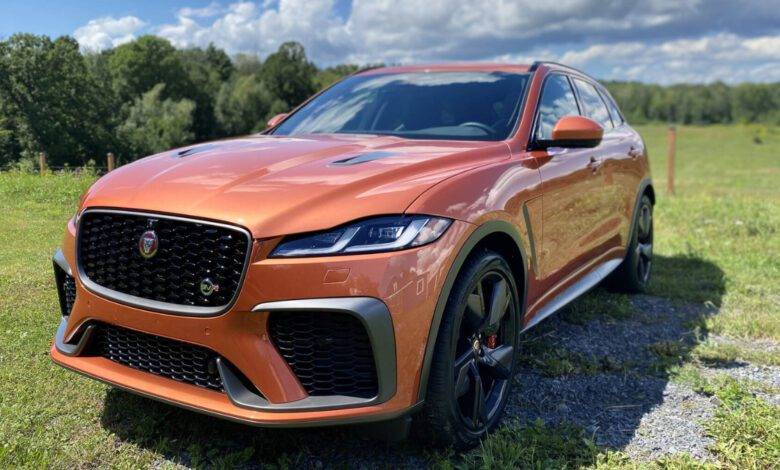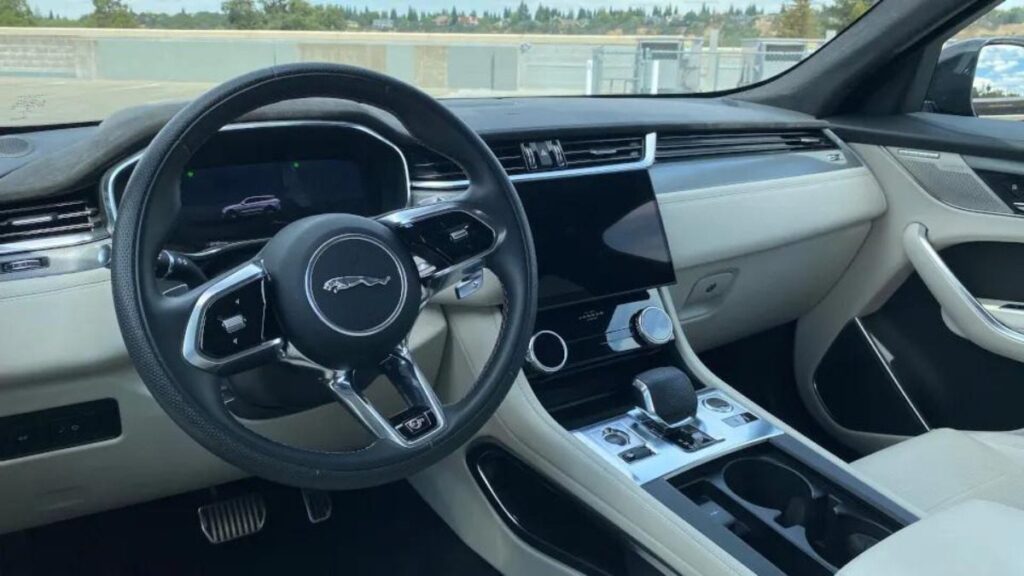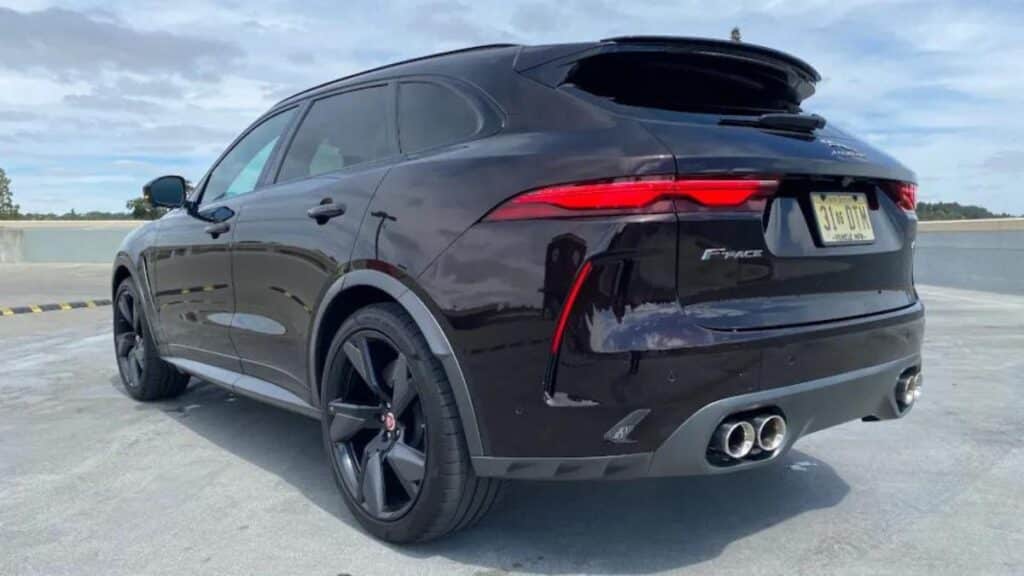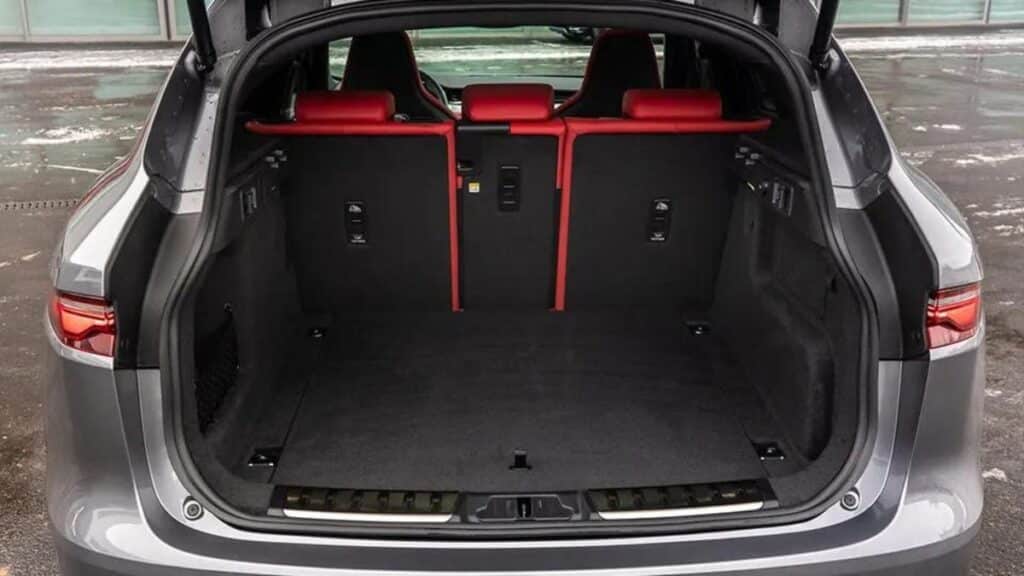Jaguar F-Pace-2023

A crossover SUV with five seats, the 2023 Jaguar F-Pace has a 113.1-inch wheelbase. There are four possible trim options and three different engines. A 2.0-liter, 16-valve inline four-cylinder with 246 horsepower powers the P 250 and P 250 S. A mild hybrid 3.0-liter, 24-valve inline-six with 395 horsepower is available for the R-Dynamic S 400. A high-performance model called the SVR is also available. It has a twin-supercharged, 5.0-litre, 32-valve V8 engine that produces 550 horsepower. All variants of the F-Pace have all-wheel drive.
The F-Pace P 250 has a base price of $53,550 (destination included). It is increasingly commonplace to use satellite navigation with What3Words software. Perforated leather seats, a motorized liftgate in the back, the Pivi Pro infotainment system, traffic sign recognition technology, and an adaptive speed limiter are all included in the P 250 S ($57,150).
The 149 more horsepower and the sport-tuned suspension account for a large portion of the R Dynamic S 400’s higher cost ($65,950). It sports unusual 19-inch wheels as well. From there, the F-Pace SVR ($90,650) represents a massive increase in both power and cost. It boasts 155 more horsepower than the R Dynamic S, 304 more than the P 250 and P 250 S, and unique 20-inch wheels. The inside is a mix of leather, suede, and fabric, and the front performance seats are heated and chilled.
Direct rivals of the Jaguar F-Pace among luxury crossover SUVs in this size range are the Audi Q5, BMW X3, and Porsche Macan. The introductory price of the Audi Q5 is $46,695, and the base price of the BMW i3 is $46,395, much cheaper than the $53,550 base Jaguar F-Pace P 250. This price difference persists through all trim levels. Except for the hot-rod GTS, which costs roughly $5,000 less than the F-Pace SVR, the Porsche Macan is more expensive than the Jaguar in every model. However, the Jaguar outperforms the Porsche by 116 horsepower.



We drove an F-Pace SVR for a week and found it significant, cozy, and quiet—until you stepped on the gas—delightful growl results from doing that. There is an option that allows you to increase the exhaust’s volume, although doing so can attract the notice of the local authorities. The SVR has improved handling and braking to match the available power. The SVR seems to be a top-tier luxury SUV when driven, usually lightly.
The F-Pace SVR’s split personality could be its best quality. The driver chooses whether to engage in exuberant bursts of speed and handling or be pampered by a luxury vehicle. What distinguishes it from the most popular versions of the X3 and Macan, which often focus only on sport?
Performance:
The basic F-Pace seems to be a good match for the Audi Q5, BMW X3, and Porsche Macan models. However, the Jaguar is hefty and loses more than a second to the Audi and almost a second to the BMW and Porsche in 0-60 times. The horsepower figures for the 6-cylinder variants of each car are equally comparable, yet the Jag accelerates to 60 mph at least half a second more slowly than any of them. Only when paying for the SVR can the F-Pace beat the BMW X3 M, which costs about $17,000 less, in the dash to 60 mph, clocking in at 3.8 seconds. The steering accurately reacts to inputs, but there is more of a sensation of heaviness than any actual connection to the road. Given the size and weight of the Jag, the brakes are more than sufficient.
Fuel efficiency:
With an average of 23 miles per gallon across its entire lineup, Audi beats Jaguar, BMW, and Porsche for the honors in fuel efficiency. The Porsche Macan GTS achieves 19 miles per gallon in its high-performance trims, while the BMW X3 M and Jaguar F-Pace SVR average 17 miles per gallon.
The four-cylinder F-Pace gets 24 mpg combined, 22 in the city and 27 on the interstate. The P340 and P400 versions, which use 3.0-liter mild hybrid engines, get 22 mpg combined, 20 mpg in the city, and 22 mpg on the highway (1 mpg less for the P400 city and highway). Last but not least, the EPA rates the F-Pace SVR at 17 mpg combined, 15 towns and 21 streets.
Safety and driver support technology:
Neither the National Highway Traffic Safety Administration nor the Insurance Institute for Highway Safety have given the Jaguar F-Pace a crash test grade. Additionally, neither the Australian ANCAP nor the Euro NCAP has rated it. Despite this, it has a comprehensive set of driver-assistance safety technologies and would presumably crash well based only on mass. For a vehicle of its size, it offers excellent visibility as well. No accident data, however, lowers its overall rating. Porsche lacks crash test information for the Macan as well. Still, the NHTSA has given the Audi Q5 and BMW X3 5-star ratings, and the Insurance Institute for Highway Safety has given both vehicles an excellent overall grade.
Forward collision warning, automated emergency braking, blind-spot detection, rear cross-traffic alert, lane departure warning, lane-keeping assistance, and automatic high lights are all included in the standard safety technology. The options include parking assistance, a head-up display, traffic sign recognition, and adaptive cruise control.
Comfort and Space
The Q5’s back seat has eight-tenths of an inch more legroom than the F-Pace’s, the second roomiest of the rivals. On the other hand, the Jag boasts more excellent back legroom than the X3 by eight-tenths of an inch and more than an inch and a half more than the Macan. Front seat comfort is outstanding, even with the bolsters in the SVR variant we tried, indicating the F-Pace would be a decent option for extended road trips.
Infotainment: Jaguar F-Pace
Jaguar made a 14-speaker, 380-watt Meridian audio system with a twin subwoofer standard in all grades when it updated the F-Pace in 2021. It has an 11.4-inch touchscreen for operation and is Apple CarPlay and Android Auto compatible. Devices may now be charged wirelessly. We had no connectivity troubles, and inputs were rewarded with prompt answers.
Storage & Cargo Space:
The Jaguar F-Pace has 65 cubic feet of cargo space when the second row of seats is folded flat, outpacing the competition. The Audi Q5 and Porsche Macan are much behind, coming in at 54.1 and 53.0, respectively, while the BMW X3 comes in second with 62.7. The Audi has a tiny edge over the Jaguar with the second row in place (38.0 to 37.2 cubic feet), while the BMW and Porsche each have 36.4 and 35.6 cubic feet, respectively.
Design: Jaguar F-Pace
With minor creases around the lower body, cat-like LED headlights, and a prominent, aggressive grille with tiny air intakes on each side, the F-Pace stands apart from the standard design of a crossover SUV. The F-Pace also has a threatening appearance from behind, thanks to prominent twin exhausts. The F-Pace looks like a performance car, even in more affordable variants. The uniqueness of the F-Pace, which is less popular than the Audi and BMW in many areas, contributes to its appeal.
The Jaguar F-Pace 2023: Is It Worth It?
The F-Pace is a severe competitor in sport/luxury 5-seat crossover SUVs. Unfortunately, nobody purchases a Jaguar to drive slowly, and the 2.0-litre versions struggle to stay up with the competition 0-60 times. The SVR is undoubtedly the victor of the stoplight drag race, but with a price tag of $90,650, it’s difficult to argue for value.
If we had to choose, we’d select the R Dynamic S because its 355 horsepower reduces the time needed to accelerate from 0 to 60 mph to a respectable 5.1 seconds (still slower than the competition, but objectively swift), and its $65,950 price is affordable considering what you receive.
How Much Does the Jaguar F-Pace Cost to Insure?
The insurance rates for the Jaguar F-Pace are somewhat higher than those of its top rivals. Our findings show that the average yearly premium for a 30-year-old female driver with a clean driving record will be $2,869 for the F-Pace P340S and much higher at $4,550 for the F-Pace Type R. The average price for the Audi Q5 is $2,550, compared to $2,293 for the BMW X3 30i, $2,943 for the BMW X3 M, and $2,549 for the base Porsche Macan GTS.




